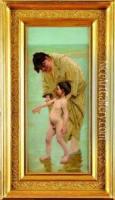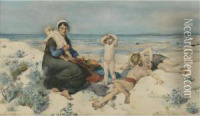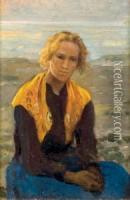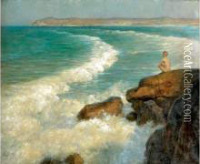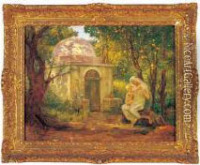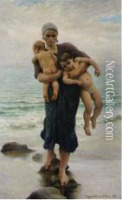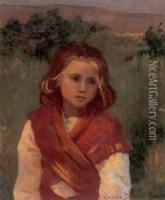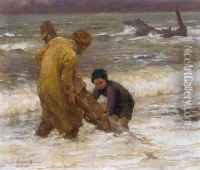Virginie Demont-Breton Paintings
Virginie Demont-Breton was a prominent French artist born on June 26, 1859, in Courrières, a small town in northern France. She hailed from an artistic family; her father, Jules Breton, was a well-known realist painter, and her mother, Elodie de Vigne, was also an accomplished artist. This environment nurtured her talents from a young age. Demont-Breton showed an early affinity for the arts and was trained by her father, which greatly influenced her style and subject matter.
Her work often depicted the lives and struggles of the coastal fishermen and their families, a theme that was close to her heart as she spent much of her life in Wissant, a fishing village on the coast of Pas-de-Calais. She was particularly noted for her ability to capture the harsh realities of life at sea and the emotional depth of her subjects. Her painting style ranged from realism to symbolism, and she worked primarily in oil painting.
Demont-Breton achieved significant recognition in her lifetime. She was one of the first women to be elected to the Société des Artistes Français in 1890, and she served as the organization's vice-president from 1910 to 1920. In 1894, she was awarded the prestigious Legion of Honour by the French government for her contributions to the arts.
Her personal life was marked by her marriage to fellow artist Adrien Demont, with whom she had a son, Maurice Demont, who also became an artist. Virginie Demont-Breton was committed to supporting female artists and was a founding member of the Union des Femmes Peintres et Sculpteurs. She worked tirelessly to promote equality for women in the art world, a legacy that is still remembered today.
Demont-Breton's work has been exhibited internationally, and her paintings can be found in many prominent museums in France and around the world. She continued to paint and exhibit her work well into her later years. Virginie Demont-Breton passed away on January 10, 1935, in Paris, leaving behind a body of work that continues to be celebrated for its emotional depth and technical mastery.

